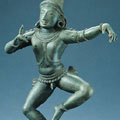|
|
 |
 |
| Saints |
|
|
The beloved abode of the handsome Lord
and the fair Goddess with the beautiful hair
is Canpai town,
where the Himalayan Gods
come down to praise him,
singing, "O Lord who dwells in our hearts,"
and perform the evening rite
worshiping with incense and lamps.
By Campantar [Sambandar], 6th-7th centuries
Translated by Indira Viswanathan Peterson, Poems to Shiva: The Hymns of the Tamil Saints (Princeton Library, 1989), p. 180.
Tirunanacampantar (popularly known as Sambandar or Campantar) was one of the earliest and most important of the sixty-three Nayanars, "leaders" who were devoted to Shiva (Figure 1). A 6th-7th century poet who sang of his devotion to God in Tamil, this saint is one of the earliest figures associated with Tamil devotional (bhakti) tradition. Bhakti has never been a disinterested or obligatory devotion to God: it is often ecstatic and always personal. Poets are described in the poems and later hagiographical writings as traveling among the sacred shrines of the Tamil countryside, singing of their devotion to their Lord and God. The later poet Mannikakkavacaka was another important Shiva devotee from the Tamil-speaking regions of south India; he is known as one of the preceptors of the tradition (Figure 2).
These poems and the saints who sang them profoundly shaped Tamil devotional culture. The poems are still sung at temples during ritual services as offerings to God, at the behest of kings and private citizens. Today, singers (otuvar) stand outside the central shrine during the daily worship services (puja) and sing at the end of the cycle of sixteen components (known as upachara) that form the core of the ritual service. While devotional literature from other parts of India protested against temple-based worship and ritual, the works of the Tamil poets devoted to Shiva sang its praises. Poems by Sambandar and other saints are dedicated to particular locations in the Tamil cultural and linguistic region, and temples and shrines are extolled. The poems focus on the blessing of seeing the great God, and bring this experience to listeners by evoking the sacred image in all its glory. Powerful love and personal devotion shape the poems, bringing God to the listener by commemorating a vivid visual and physical experience of the image and the sacred place.
The works of Sambandar were compiled in the Tevaram, which is one of the first extant Hindu devotional (bhakti) and sectarian texts in a vernacular language rather than in Sanskrit, the formal language of religious practice and theology. Manikkavachaka's works were compiled in the Tiruvacakam. Unlike other vernacular languages, Tamil had an established classical literary canon from the beginning of the first millennium, but the Tevaram constitutes the first mainly religious text in Tamil.
< previous next >
Top |
|
 |
 |
| Click for details |
 |
 |
 |
Fig. 1
|
 |
 |
 |
Fig. 2
|
 |
|
 |


